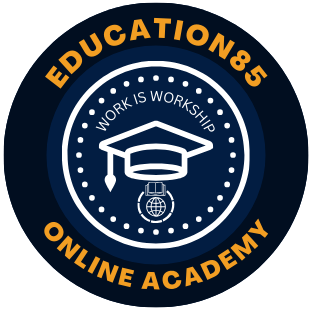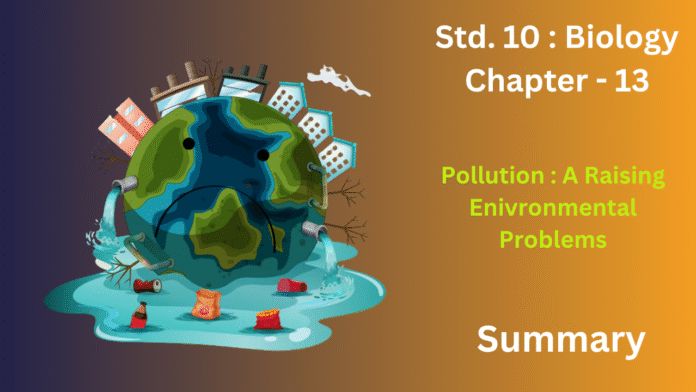This chapter explains that pollution happens when harmful substances, called pollutants, are added to our environment, making air, water, and land dirty and dangerous for living things.
1. The Main Types of Pollution:
Air Pollution: Caused by smoke, dust, and poisonous gases from vehicles, factories, and burning fuels.
Water Pollution: Caused by dumping sewage, factory chemicals, and farm pesticides into rivers, lakes, and oceans.
Land Pollution: Caused by littering the ground with plastic, chemicals, and other solid waste.
Noise Pollution: Caused by excessive and loud sounds from traffic, loudspeakers, and industries.
2. Key Pollutants and Their Harmful Effects:
Carbon Dioxide & Methane: These are greenhouse gases.
Sulphur Dioxide: This gas mixes with rain to form acid rain, which harms forests, aquatic life, and buildings.
Chlorofluorocarbons (CFCs): These chemicals damage the ozone layer, which acts as our shield against the sun’s harmful ultraviolet (UV) rays.
Non-Biodegradable Waste: Materials like plastic and pesticides like DDT do not decompose naturally. They remain in the soil and water for many years, poisoning the environment.
Radioactive Wastes: Released from nuclear activities, these can cause serious illnesses like cancer and genetic damage.
3. How We Measure Pollution:
A common method is BOD (Biochemical Oxygen Demand). It measures how much oxygen bacteria in water consume while breaking down waste. A high BOD means the water is heavily polluted, often with sewage or organic waste, as there is less oxygen left for fish and other aquatic life.
4. Our Role in Controlling Pollution:
It is our responsibility to reduce pollution. We can all help by:
Using public transport, cycling, or walking to cut down on air pollution.
Properly disposing of garbage and recycling materials like paper, glass, and plastic.
Using compost and other natural fertilizers instead of harsh chemicals in farming and gardening.
Planting more trees, which clean the air, protect the soil, and help reduce noise.
In short, a clean environment is vital for our health and survival. We must all act responsibly to protect our planet from pollution.
A. MULTIPLE CHOICE TYPE
(Choose the correct option)
1)Which one of the following is an example of pollutant?
(a) A rat entering your kitchen.
(b) CO2given out by the respiring organisms.
(c) The heat given out while cooking food.
(d) The dust raised during road-cleaning.
Ans: (d) The dust raised during road-cleaning.
2) Which one of the following is a “dirty” practice contributing to pollution and seriously needs stoppage by educating the public?
(a) Too loud marriage musical bands.
(b) Disposing of corpses in rivers.
(c) Pleasing lighted earthen lamps (“deejas”) in rivers.
(d) Wearing scenecl/petfumed clothes.
Ans: (b) Disposing of corpses in rivers.
3)One of the examples of a non-biodegradable pollutant is:
(a) Paper
(b) DDT
(c) Vegetable peel
(d) Cotton
Ans: (b) DDT
B. VERY SHORT ANSWER TYPE
1)Name the following:
(a) The pollutants which are naturally decomposed.
(b) The pollutants which do not decompose naturally.
Ans: (a) Biodegradable pollutants
(b) Non-biodegradable pollutants
2)Match the pollutants given in Column I with their major source in Column II.
| Column I (Pollutant) | Column II (Source) |
| 1)Cholrofluocarbons(CFCs) | 1)Global Warming |
| 2)Flyash | 2)Biodegradable |
| 3)Cow dung | 3)Nuclear Radiation Pollutant |
| 4)C02 and Methane | 4) Acid Rain |
| 5) Sulphur dioxide | 5)Industrial Waste |
| 6)Iodine 131 | 6) Ozone Depletion |
Ans:
| Column I (Pollutant) | Column II (Source) |
| 1)Cholrofluocarbons(CFCs) | 6) Ozone Depletion |
| 2)Flyash | 5)Industrial Waste |
| 3)Cow dung | 2)Biodegradable |
| 4)C02 and Methane | 1)Global Warming |
| 5) Sulphur dioxide | 4) Acid Rain |
| 6)Iodine 131 | 3)Nuclear Radiation Pollutant |
C. SHORT ANSWER TYPE
1) List two major harmful effects of each of the following:
(i) Industrial waste released into rivers.
(ii) Pesticide like DDT used in agriculture.
(iii) Burning of fossil fuels.
Ans: (i) Industrial waste released into rivers:
It kills aquatic life (like fish and plants) by poisoning the water and using up the oxygen.
It makes the water unsafe for drinking, bathing, and irrigation, leading to diseases like cholera and poisoning from heavy metals.
(ii) Pesticide like DDT used in agriculture:
It enters the food chain and accumulates in the bodies of animals and humans, causing long-term health issues like cancer and harming reproductive systems.
It kills not only pests but also beneficial insects and birds, disrupting the natural balance of the ecosystem.
(iii) Burning of fossil fuels:
It releases harmful gases and particles that cause respiratory diseases (like asthma and bronchitis) and heart problems in people.
It releases a large amount of carbon dioxide, a greenhouse gas, which is the primary cause of global warming and climate change.
2)List the five major sources of air pollution.
Ans: The five major sources of air pollution are:
- Vehicle Emissions: Smoke and harmful gases released from cars, trucks, and other motor vehicles.
- Industrial Activities: Smoke and chemical waste released from factories and power plants.
- Agricultural Activities: Dust from farming, burning of crop residue, and pesticides sprayed in the air.
- Burning of Fossil Fuels: Coal, petrol, and diesel burned for energy, heating, or cooking.
- Natural Sources: Dust storms, volcanic eruptions, and smoke from forest fires.
3) What are the vCommon sources of oil spilles ,and how do they affect sea life
Ans: Common Sources:
Accidents involving large oil tankers during transportation.
Leaks from offshore oil drilling rigs and pipelines.
Waste oil released from ships or from industries located near coasts.
Effects on Sea Life:
The oil forms a thick layer on the water surface, blocking sunlight and reducing oxygen levels.
It coats the feathers of seabirds and the fur of marine mammals, destroying their natural insulation and causing them to drown or die from cold.
Fish and other sea creatures ingest the toxic oil, which poisons them and can cause long-term health problems or death.
It destroys coastal habitats like coral reefs and mangrove forests, which are crucial breeding grounds for many marine species.
4)Mention any two measures to minimize noise pollution.
Ans: Two effective measures to minimize noise pollution are:
Using Silencers: Mandating the use of silencers in vehicles and industrial machinery to reduce the noise generated by engines and exhaust systems.
Planting Trees: Creating green belts and planting trees along roads and around residential areas, as trees act as natural sound barriers and absorb noise.
D. STRUCTURED/APPLICATION/SKILL TYPE
1)A factory is built near a village and residents start falling ill. Describe the possible pollutants and their effects.
Ans: The factory could be releasing:
Air Pollutants: Such as smoke, dust, and toxic gases like sulfur dioxide. These can cause respiratory problems like asthma and bronchitis, and eye and skin irritations among the villagers.
Water Pollutants: Chemical waste discharged into a nearby river or ground water. This can lead to waterborne diseases like cholera and typhoid, as well as long-term poisoning if the water is used for drinking or irrigation.
2)Look at the picture/schematic presentation of a kind of pollution given below.
(a) Identify the kind of pollution.
(b) List two sources of this pollutant.
(c) Mention any two harmful effects of this pollutant.
Ans: a) Identify the kind of pollution.
The picture shows Water Pollution.
(b) List two sources of this pollutant.
Discharge of industrial waste directly into the water body.
Direct dumping of untreated sewage and solid garbage from the city.
(c) Mention any two harmful effects of this pollutant.
It kills aquatic life like fish and plants, disrupting the ecosystem.
It makes the water unfit for drinking and domestic use, leading to the spread of diseases in humans.


